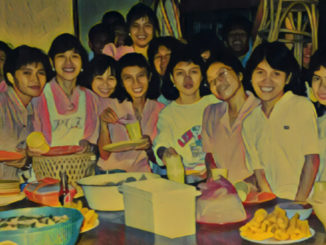Warning: do not expect to find anything in this postcard about Irish craic, trad’ music, green pastures, comely colleens, or comparisons between Murphy, Beamish and Guinness stouts. There won’t be much either about “the 850 places to see and things to do in Cork” (according to an Explore Cork app). This is a postcard from a returner, who ditched long ago the green-tinted glasses.
I hadn’t been to Cork in several years. Last time I was in Cork there were already too many new Irish, hijabijeebee women and signs in Polish for my taste. Since my last visit, I nearly lost my friends in Cork over Brexit and covid, and Trump too if I had ever opened my mouth in their company.
Making the most of a “window” of freedom (no covid vax checks on arrival, no covid testing on returning, no threat of quarantine either way, no vax pass to eat or drink out, no mandatory masks …), I wanted to revisit the place to see what was left standing after two years of covid hysteria. I lowered my expectations as much as possible.
* * *
My lowered expectations took a tumble further downwards when I arrived at the airport: Passengers were welcomed with huge signs in Ukrainian. I sighed one of my first “oh dear…” of the visit.
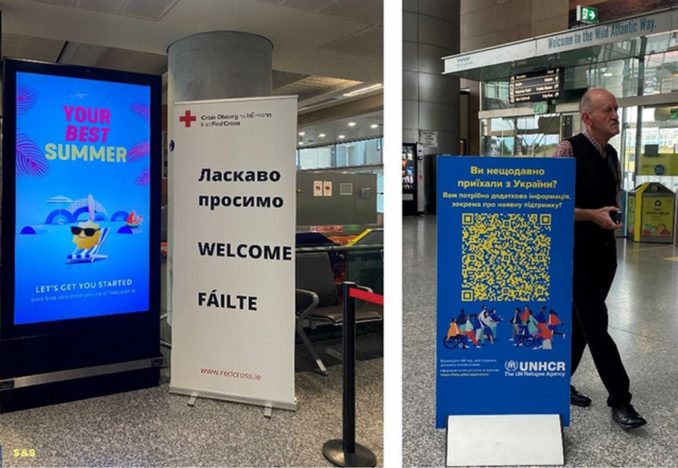
The first two taxi drivers waiting for fares outside were new Irish. We got the Muslim, complete with skullcap. His ID on the dashboard gave him away as Mohammed. He remained silent throughout the ride, you can blame it on the covid screen if you want – so much for catching up on local news with a Corkonian driver as used to happen.
Our first foray outside revealed gay rainbows everywhere, on the gates of the University, on the façade of pubs, floating on the roof of the city library, painted on the street surface as a pedestrian crossing. When you remember homosexuality was legalised as recently as 1993, and gay marriage in 2015, this is fast societal change (or is it ramming it down people’s throats?). Cork Pride was one full month earlier but obviously they like the colours, and the virtue signalling.
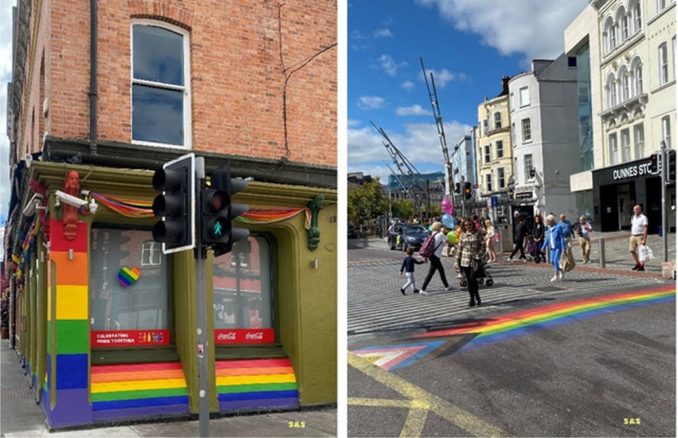
The preponderance of ukie blue and yellow colours could not be missed – flags floating outside windows, in shop windows or self-standing by the roadside; painted phone junction boxes.

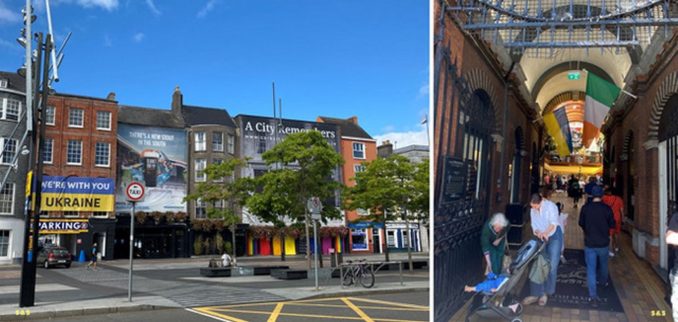
OK we get it. The Irish, “the small guy”, demonstrate solidarity towards another small country, perceived to be also under the boot of an evil Empire. No chance of questioning the narrative in such a context!
All these bright colours did not hide the fact that many shops, pubs, cafés were closed, boarded up or with their iron blinds down. We were wondering, is Cork still charmingly tatty or is it now decrepit?
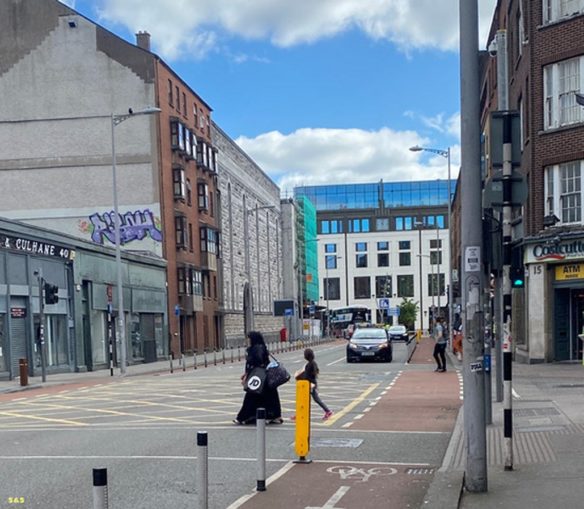
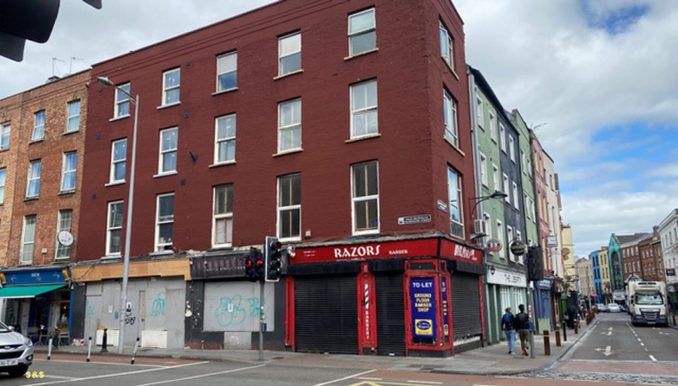
Let’s stay with the ukie theme a bit more, as it was everywhere. In Waterstones, selected books to read and selected books to buy to support the Ukraine Humanitarian Appeal were on display. Corkonians will soon be better versed than us in all things ukie…
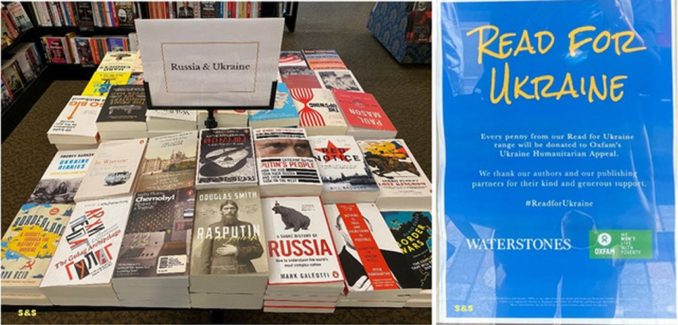
I took the next two photos without knowing what it was about. Thankfully @Powers posted a link on GP to an article in the Irish Examiner that explained it: “A Ukrainian community hub in Cork city has temporarily closed as an increase in hostility online has generated security concerns among volunteers. Following an incident at the ‘shop’ this week which was live-streamed and garnered negative attention on social media, volunteers have said they fear being attacked by some who take issue with their work.”

Meanwhile museums, banks, shops etc are beginning to cater to the New Irish.
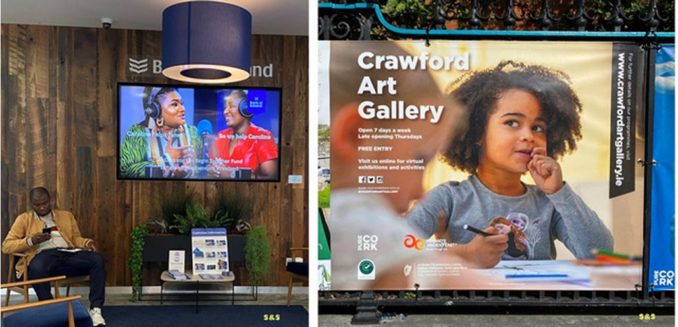
Covid lockdowns and restrictions must have been tough on retailers. Numerous Welcome Back messages could still be seen on lamp posts and rubbish bins. For memory, non-essential shops reopened on 17 May 2021.
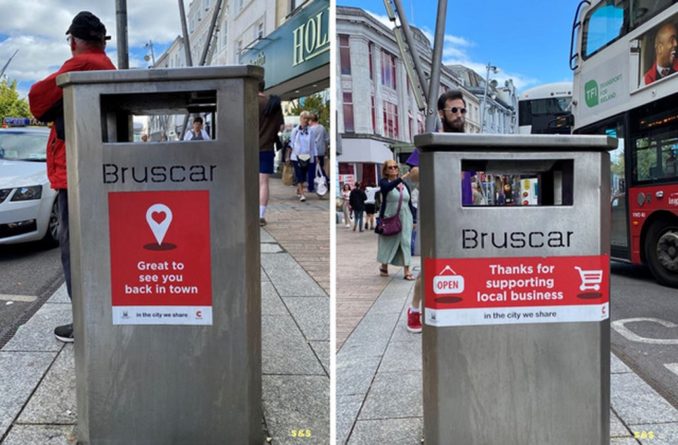
In contrast to closed premises, Turkish barbers have sprung up all over the city centre. “Karizma – bringing the traditional art of Turkish barbering to Cork”; Ahmet’s; “City Barbers, authentic Turkish barbers”; Musa’s; Zagros’; and that’s without looking for them! What is is with Turkish barbering that Corkonians need? That many Turks in Cork?
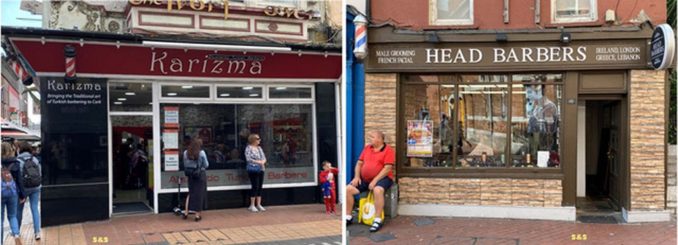
Several stores now closed are eyesores in the city centre, some for several years already. It is not quite as awful as Oxford Street but the south-eastern section of St Patrick’s Street is in danger of losing its grand air.
Among the stores closed: the Dunnes Stores anchor in Merchants Quay shopping centre, Roches Stores/Debenhams (more below), Eason’s the stationers and booksellers (supposed to reopen somewhere else on St Patrick’s Street).
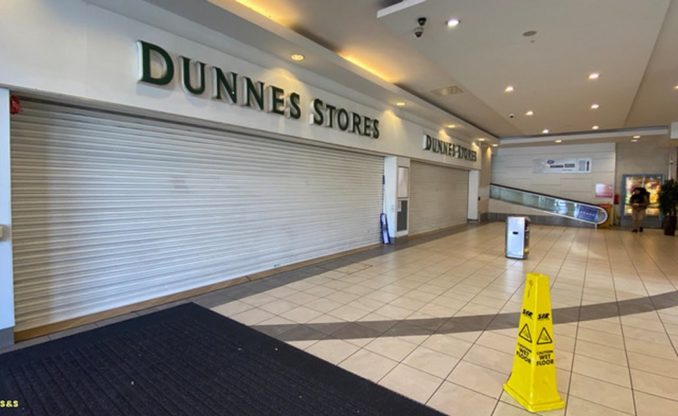
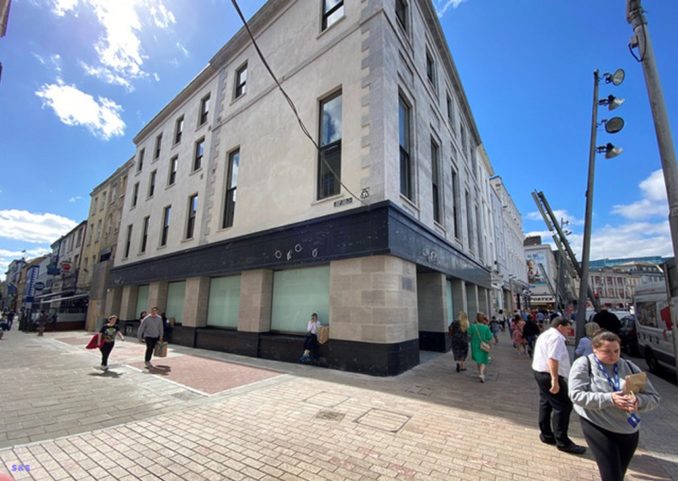
In February 2018, the oldest bookshop in the city (opened in 1916), Liam Ruiséal’s, closed down. In 2021 it was announced it was going to be redeveloped as a health food store and café. Nothing much has happened since, it seems.
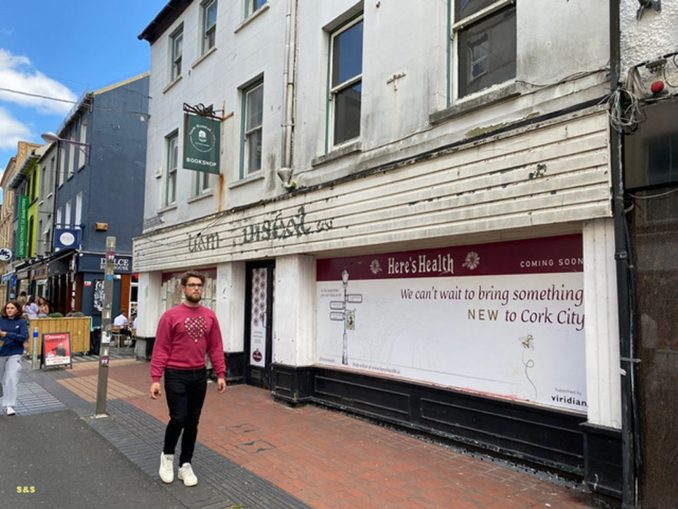
The Roches Stores building (Debenhams since 2006) has been for sale since Debenhams closed in April 2020 (with the loss of 700 jobs). Three views of it below. The front of the building is listed (as is the stunning skylight inside) so thankfully won’t be interefered with. The copper dome is another key architectural feature.
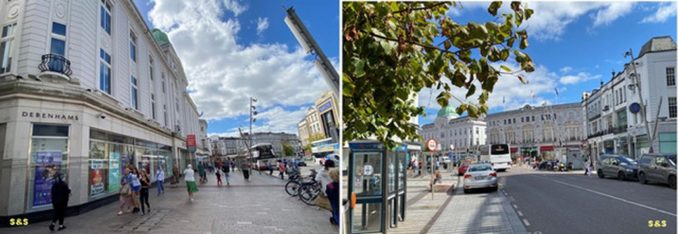
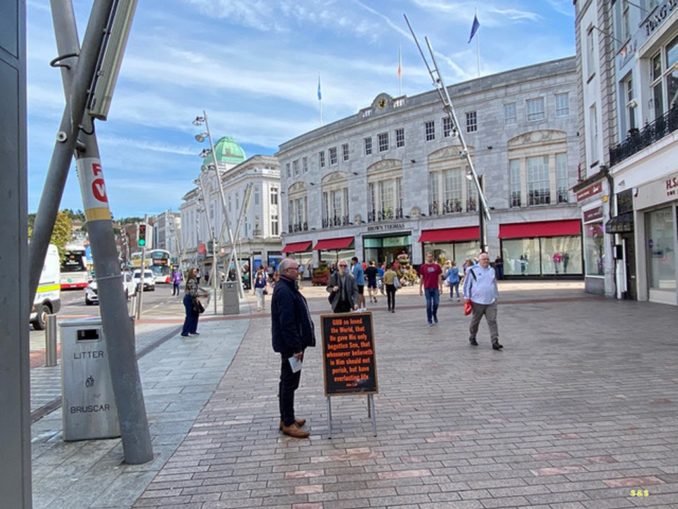
Will it be a mix of retail, student accomodation and social housing next time we visit?…
BTW the tall obtrusive structures in the photo above produce when lit both diffuse and concentrated lighting. The design is supposed to be reminiscent of ships’ masts, reflecting the city’s maritime culture, according to the Spanish architect… To others, it is a blight on St Patrick’s Street and Grand Parade, the epitome of visual pollution. The expensive street revamp was finished in 2005 when Cork was EU City of Culture.
The only vaguely sophisticated place left to shop is Brown Thomas (the building with the three flags on top, with the red awning, next to Roches/Debenhams), now part of the Selfridges group. It was a much quirkier and less “exclusive” store when it was Cash’s, i.e. until 1998. It is also a grand building, in the Regency revival style, like Roches Stores rebuilt after the 1920 burning of St Patrick’s Street, and both influenced by the design of Harrods and Selfridges.
Brown Thomas opened its Christmas shop on 18 August 2022, which might seem a bit OTT. Despite that, my immediate and overall impression was that there was nothing much to buy, with the choice of stores vastly reduced, but that there were many more places to sip a coffee or eat ethnic food (some clearly marked halal)!
The most striking thing about Cork is how it is now an outdoor city with more al fresco bars and cafés than you can shake a stick at. It seems like Corkonians spend most of their time sitting around drinking coffee. We have never seen so many cafés and bars in one town. But we did not see one that looked enticing or comfortable (bring back the old-fashioned Bewley’s tea-room, formerly in Cook Street!). In the one where we did stop for a restorative coffee, the waiter was new Irish, the slop was served in paper cups and it smelled of sewer in the street.
Post-covid, outdoor dining and drinking resumed on 7 June 2021. Ireland was one of the most cautious in the EU on the risks of covid, putting in place some of the longest-running restrictions on travel and hospitality. Indoor service only resumed on 26 July 2021 and for fully-vaccinated punters only – contact-tracing and vaccine passport via QR code. This was in force until 22 January 2022…
To help with the recovery, eateries and pubs in Prince’s Street were given giant brightly-coloured umbrellas on permanent poles by the City. This new feature completed the al fresco revolution in Cork started the previous summer. When the weather is glorious, as it was during our visit – sunshine, no showers – I could see the attraction. For Corkonians it is now a tourist attraction, – “did you see the umbrellas in Prince’s Street?”
Even Centra, the Irish convenience shop chain, has canvas café barriers outside their city centre shops. Strange, as there is no shortage of outdoor coffeeshops, they’re hardly filling a gap in the market!
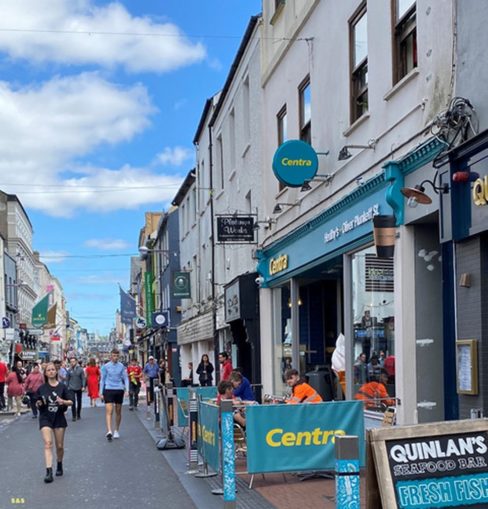
It is all very messy or joyful, depending on your point of view, but the narrowest streets are encumbered with enclosed wooden terraces or canvas barriers and their garden furniture. It has become visually too cluttered. Thankfully I didn’t see any e-scooters to hinder pedestrian circulation even more.
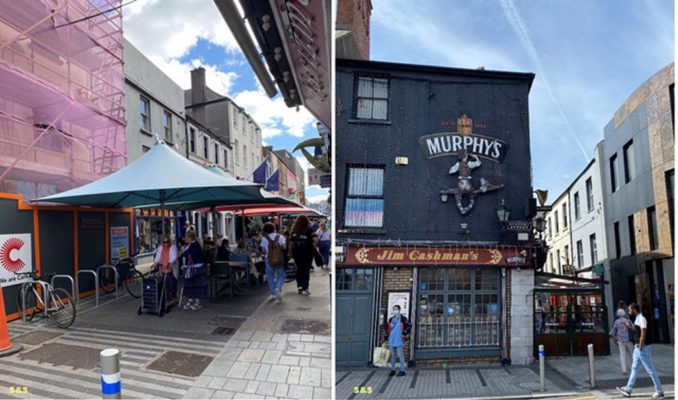
It was said in the 1980/90s that Cork (county as well as city) was the food capital of Ireland. Innovative cooking with local produce drew international attention to Ireland’s second city. Now they call it “foodie capital”. Mmm… In fact, the famous places for fine dining are gone, Arbutus Lodge, the Ivory Tower. Paradiso is still here and has added a vegan version to its vegetarian menu. The Crawford Art Gallery Café has not reopened since the pandemic. We could not get in the Farmgate Café in the 18th-century indoor English Market (the one with a plaque from the Queen’s visit) as the queues were too long. If what they mean by “foodie” is adding chorizo to every main course, especially fish, I felt like telling them that London restaurants have at last given up on this heresy and time they did too. Most restaurants and gastropubs looked to us loud and uncomfortable, a modern feature.
The hipster vibe is definitely due to a large student population.
The University, UCC, is one of the top employers in the area. UCC have expanded all over the city, well beyond the original campus, buying up buildings as far as the town centre, on the way to the airport etc. Cork is now a city attached to a university, rather than a city with a university. In 2017 it revealed ambitious plans to expand its campus space by 20% over the next five years, “as part of a €350m investment and a strategy to grow student numbers from 20,000 today to 23,000 by 2022. […] International students will account for half of the increase in student growth numbers.” It has now reached its goal of 23, 000 students! To think that in 1975, the College had approximately 3,250 students, in 2005, close on 16,000 students… This growth explains the changes in the dining experience, I would venture. Cork is now a student economy.
This summer student accommodation has been occupied by Ukrainian refugees and, by the time of our visit, the question was acute about where they are going to be housed when the students come back for the beginning of college term. More than 2,500 Ukrainian refugees who have been housed in student accommodation around the country since the start of the summer were to be relocated by the end of August. Up to 2,000 more were likely to be moved by mid-September.
The State is providing accommodation for 33,000 people who have fled to Ireland, the vast majority in hotels. More than 6,000 Ukrainians currently work, and all receive EU benefits and protections. More than 7,000 children are enrolled in schools across the country.
* * *
My heart sank every time I spotted that all the covid paraphernalia was still in place all over town, making it impossible for people to forget, move on, and relax. Shop check-outs still had their Perspex screens, so did taxis, which made them very cramped and made conversation with the driver difficult; social distancing stickers still on the floor, hand and caddie sanitiser stations, signs requiring the wearing of masks when they have not been mandatory since the end of February 2022, mask vending machines still in operation at the airport! The whole place looks ready for the next wave!
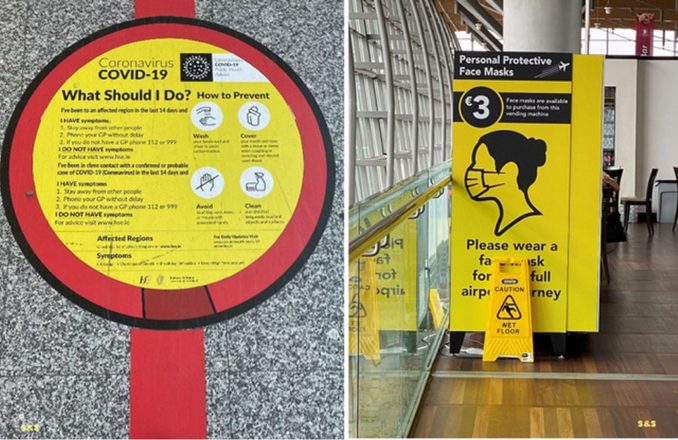
photo 19 – covid stickers & masks
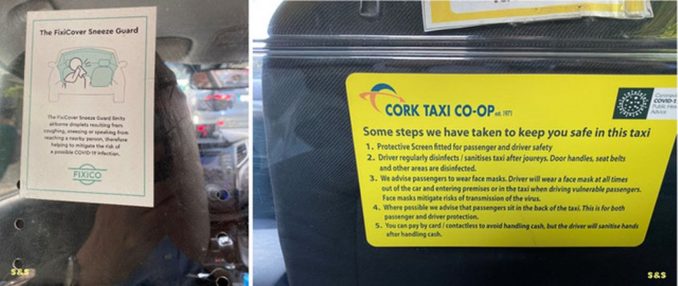
Thankfully, some simple pleasures have not changed, like sitting on a street bench to listen to musicians.

At the other end of the street above, French Church Street, and turning left is Rory Gallagher Place and the tribute to him:
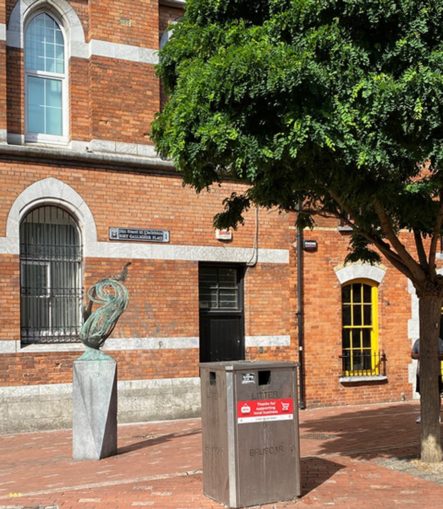
The bronze sculpture by Cork artist Geraldine Creedon takes the form of a guitar on one side, with the other side made up of intertwined lyrics from Gallagher’s 1982 album, Jinx. It was unveiled in October 1997. A memorial easy to miss, on a somewhat run down place with seedy food joints. Hoodies, idle vapers, shoppers and Deliveroo cyclists did not seem to care. Gallagher is buried outside of Cork, in Carrigrohane.
* * *
As for meeting with residents of Cork, I found to my dismay that the recent years of Brit-Breggzit-bashing have taken their toll. The Irish MSM have managed to brainwash people I would have credited with more critical sense. Despite their own two referenda, twice, they’re now firmly on the side of the EU (“Ireland has benefitted so much”) and were all for the way the UK was treated in the negotiations with the EU, the Northern Ireland Protocol, eco-loon policies, the politicians’ handling of the covid epidemic etc. None were much bothered by the civil liberties implications of the latter. Interestingly Ukraine was not mentioned. When the Irish are not at ease with a topic, they do not mention it at all.
Now back home and reading up to flesh out this article, the place I’ve just visited is still just recognisable in these lines of the Irish Tourist Board: “Sitting proudly on an island in the middle of the River Lee, Cork’s feelgood buzz surges through its hip coffee shops, vibrant art galleries, off-beat museums and seriously good pubs. Despite being a city, there’s a decidedly towny feel here – life is laidback, nothing is too much hassle. Pleasantly compact, friendly and with a wry sense of humour, Cork does things its own way, which makes a break here feel totally unique.”
I realise at the end of this postcard that it is as much about the past as it is about the present. Sorry for the whiff of nostalgia. However, despite the critical look, it turned out to be a pleasant visit which feels more-ish.
© text and images Sunshine&Showers 2022


